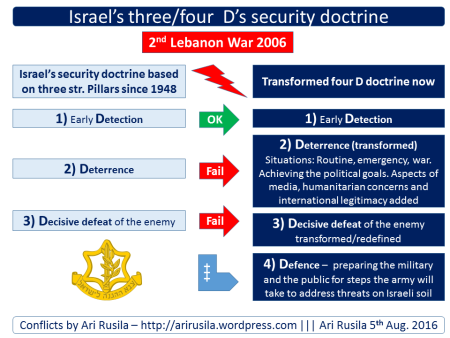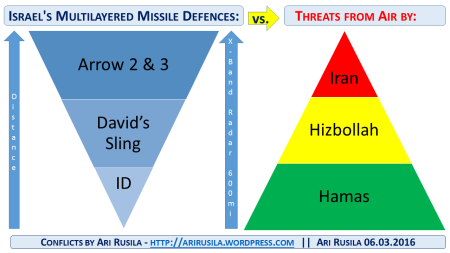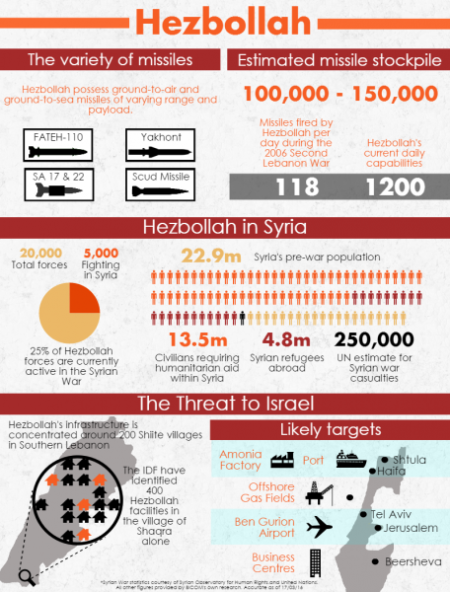 A decade has passed since the Second Lebanon War in 2006. This time interval makes it possible to analyze the lessons learned of that war.
A decade has passed since the Second Lebanon War in 2006. This time interval makes it possible to analyze the lessons learned of that war.
Israel government’s failure to achieve its self-declared war aims, the relatively high Israeli death toll – 120 Israeli soldiers and 43 civilians – and the heavy impact of Hezbollah rocket fire on the civilian population in Northern Israel, shocked and angered the Israeli public. Meanwhile Israel faced international condemnation, accused of using ‘disproportionate’ force in its military operations in Lebanon. With many Israelis demanding the resignation of the prime minister, defence minister and IDF chief of staff, the government set up a commission of inquiry chaired by retired judge Eliyahu Winograd.
2nd Lebanon War
The Lebanon and Israel War went from the 12th July 2006 to 14th August 2006. It was a 34 day military conflict in Lebanon and northern Israel. The principal parties were the Israeli military and Hezbollah paramilitary. Hezbollah was responsible for a raid in 2006 on a border post in Northern Israel in which two Israeli soldiers were taken captive. The abductions sparked an Israeli military campaign against Lebanon to which Hezbollah responded by firing rockets across the Lebanese border into Israel.
On the morning of July 12, 2006, two Israeli soldiers were kidnapped and eight others killed when Hezbollah fighters carried out a surprise cross-border raid, thus effectively ending the sixyear period of relative quiet that had existed along the Israel-Lebanon border following the unilateral withdrawal of the Israel Defence Forces (IDF) from Lebanon in May 2000.
What later became known as the Second Lebanon War ended 34 days later on August 14th 2006, when the United Nations Security Council Resolution (UNSCR) 1701 – which called for the disarming of Hezbollah, the withdrawal of its troops from the border with Israel and the deployment of the Lebanese Army in the southern part of the state – went into effect.
![2nd Lebanon War – Lessons Learned Lebanon[1]](http://m5.paperblog.com/i/152/1521909/2nd-lebanon-war-lessons-learned-L-XC0Zix.jpeg)
The Winograd Commission
The Winograd Commission’s final report [over 600 pages in Hebrew, cfr summary in English] on the government’s handling of the Second Lebanon War referred to it as “a great and grave missed opportunity” with its harshest criticism aimed at the military and political leadership. In particular, the commission found “serious failings and flaws in the quality of preparedness, decision-making and performance in the IDF high command… [and] serious failings and flaws in the lack of strategic thinking and planning, in both the political and military echelons,” noting that the “inadequacies of preparedness and strategic and operative planning go back long before” the war. Among its many criticisms, the commission found that the cabinet had failed to formulate clear objectives and policy options.
Based on an extensive range of documents and testimonies, the most prominent of which was the report issued by the Winograd Commission, Israel’s objectives for the operation may be summed up as follows: to bring about a change in the security situation and lift the terrorist threat imposed by Hezbollah out of Lebanon on the State of Israel by devising new rules and changing the balance of deterrence vis-à-vis Hezbollah; to restrict Hezbollah’s freedom of operation, to inflict a substantial blow to its capabilities and status; to enhance (Israel’s) regional deterrence by demonstrating the price of aggression against Israel; to motivate Lebanon to apply its sovereignty in its entire territory and impose restrictions on Hezbollah, including the removal of Hezbollah’s posts along the border followed by the Lebanese Army deploying in southern Lebanon; to call in international involvement in order to enforce the relevant UN resolutions and the ceasefire mechanism (based on UN Resolution 1559) and finally – to create the conditions for the return of the abducted soldiers.
Several constraints and restrictive conditions were specified for the operation, notably: keeping casualties among the combat elements to an absolute minimum; avoiding a large-scale war in Lebanon, particularly against Syria; no Israeli presence to remain in Lebanon after the end of the confrontation; maintaining Israel’s international legitimacy and maintaining the legitimacy of the operation among the Israeli public.
The aspect of combined-arms operations and interoperability turned out to be one of the primary failures in the employment of force during this operation. Prior to the operation, IAF had not attended any in-depth brainstorming and planning sessions with the General Staff or IDF Northern Command. During the operation in Lebanon, each arm executed its missions almost independently. The missions had been planned separately and the options for combined-arms operations involving a supporting element and an element being supported were hardly utilized.
One of the mission categories that had not been planned and was not sufficiently pursued is target acquisition and “hunting” during the actual combat operations, despite the fact that at the end of the fighting, this mission category recorded a high level of achievement relative to the expectations. The factor that made a decisive contribution to the successful execution of this mission category was the massive employment of the IAF’s UAV layout. [Source: Israel Defense ]
The intelligence aspect
 The crux role of intelligence was evident with sc “Night of the Fajr Rockets” and the success of Operation Specific Gravity in which IAF destroyed dozens of Fajr medium-range rocket launchers. These rockets had been concealed in houses and were a part of one of Hezbollah’s top secret projects. The successful elimination of those rocket launchers was made possible by exceptional intelligence achievements and deep penetration. This accomplishment led to distress among the ranks of Hezbollah, as thorough backtracking and self-examination were required in order to attempt and understand how Israeli intelligence had managed to penetrate to such depths.
The crux role of intelligence was evident with sc “Night of the Fajr Rockets” and the success of Operation Specific Gravity in which IAF destroyed dozens of Fajr medium-range rocket launchers. These rockets had been concealed in houses and were a part of one of Hezbollah’s top secret projects. The successful elimination of those rocket launchers was made possible by exceptional intelligence achievements and deep penetration. This accomplishment led to distress among the ranks of Hezbollah, as thorough backtracking and self-examination were required in order to attempt and understand how Israeli intelligence had managed to penetrate to such depths.
According Israel Defense one of the members of the Winograd Commission stated: “The problem with the War did not concern the intelligence aspect.” This is a substantial statement, as the intelligence balance during the Second Lebanon War was indeed mixed and complex and could not be defined in terms of success or failure, but rather as a collection of numerous failures in various activities alongside significant success stories. To make things even more complex, gaps and even tensions and differences between some intelligence elements and senior officers of the IDF General Staff were clearly evident.
The report refers to two distinct periods: the intelligence preparations between the year 2000 and the outbreak of the War, and the performance of the military intelligence during the war. With regard to the aspect of “Operational Intelligence” (strategic intelligence) as per the Commission’s definition, “The accomplishments of the intelligence analysis activity at the General Staff and Northern Command in the period prior to the war were substantial.” Referring to the interface between the intelligence and the political-defense echelon and the decision-making process during the War, the Commission had some criticism that referred mainly to the gap between the potential and the actual ability of the intelligence to influence the decision makers and the actual occurrences: “Apparently, one area where the intelligence community had a more substantial ability to influence the War was in the context of the decision-making process on July 12 and the first few days thereafter, including the first few days of the War. This time, more than at any other time, when the professional echelons of the IDF Intelligence Directorate had the key to cracking the enemy’s riddle, they failed to exploit it opposite the military and political leaders. While the intelligence concept was generally correct, failures occurred in the process of submitting it to the leaders.”
In this context, Major (res.) Amir Dahan, a judge in civilian life as well as in IDF and a deputy commander of a reconnaissance intelligence company in his secondary capacity, stated in an article he published in the periodical “Ma’arachot” after the War, that one phenomenon encountered again during the War involved the fact that excellent had been available at the brigade and battalion level, but that intelligence almost never reached the company and platoon level and the individual troopers, and the intelligence that they did receive was faulty. [Source: Israel Defense ]
The outcome 10 years after
 According a fresh BICOM Strategic Assessment the lessons learned since 2nd Lebanon War are following:
According a fresh BICOM Strategic Assessment the lessons learned since 2nd Lebanon War are following:
On the eve of the tenth anniversary of the Second Lebanon War, a future war with Hezbollah is considered the most threatening scenario for the IDF due to the organisation’s significant military capability.
In light of the failure of an ‘enhanced’ UN force to prevent Hezbollah rearming, Israel is sceptical of relying on international forces to defend its borders, a policy that has consequences for the security component of negotiations over the establishment of a Palestinian state.
The IDF’s new security doctrine reflects a focus on non-state actors and asymmetric warfare, and establishes new military and strategic approaches as well as redefined standards of what victory means. IDF’s
Israel’s political leadership has failed to fully implement recommendations for improving the national security decision-making process that were exposed during the war.
Israel’s security doctrine was altered by the Second Lebanon War
Since its establishment in 1948, Israel’s security doctrine has been based on three strategic pillars, often referred to as the three “D’s” – deterrence, early detection, and the decisive defeat of the enemy (military decision).
Yet the 2006 Lebanon War marked a turning point in Israel’s strategic priorities, with the threat of engaging in armed conflict with conventional armies shifting. Instead, Israel’s military and political leadership were forced to grapple with developing a response to asymmetric conflicts against actors who, while being non-states, possessed the military capacity and strength akin to regular armed forces, and had no ‘political address’ with whom to engage in postwar diplomacy. Moreover, Israel’s inability to militarily defeat these non-state actors enabled them to capitalise on a narrative that they won the war, as Hezbollah claimed in 2006. In light of the Second Lebanon War, two of the classic pillars of Israel’s traditional security concept – deterrence and decisive victory, both of which were further challenged in subsequent conflicts in Gaza – underwent a radical transformation.

New national security strategy
The IDF has learned from its failures in the Second Lebanon War and from subsequent wars between Israel and Hamas in Gaza. The Israel Defense Force (IDF) Chief of Staff Gadi Eizenkot published on 13th August 2015 a document outlining IDF strategy, including the threats facing Israel and plans to combat them. This is first time- in 60 years – since 1950s when Israeli PM David Ben-Gurion accepted military defense strategy of Israel.
The document highlights major changes in Israel’s strategic landscape, noting that the main threat confronting Israel today is from violent and wellarmed non-state organisations such as Hamas and Hezbollah, which have forced Israel into five instances of armed conflict in the past ten years (including Operation Summer Rains in Gaza in June 2006).
The document details what can be expected from the IDF during three types of situations: Routine time, emergency situations and wartime. Based on this division, conflicts like Operation Protective Edge and Operation Pillar of Defense are considered confrontations limited in their scope and are therefore define as “emergency,” rather than “war.” This means these confrontations were meant to bring Israel “back to a situation of calm, without striving for an immediate strategic change,” so the IDF cannot be expected to bring down the Hamas regime in Gaza in such a military campaign, unless the political leadership tells it otherwise.
Responding to the challenge posed to Israel’s security by these hybrid actors, the doctrine updates one of the three D’s, “deterrence” – a central pillar of Israel’s security doctrine – clarifying the IDF’s role in developing a means for prolonging the period between wars. Moreover, the strategy redefines the concept of “military decision”, tying it to “achieving the political goals set for the campaign, leading to a postwar improved security situation”. This reflects an acknowledgment that in asymmetric conflict, conclusive defeat or surrender of the enemy should not typically be the expected outcome. The strategy also emphasises the importance of international media, humanitarian concerns and international legitimacy as relevant to the IDF’s ability to fight.
Eisenkot’s strategy confirms the addition of a fourth “D” – “defence” – to Israel’s core security pillars: “defence” – described as preparing the military and the public for steps the army will take to address threats on Israeli soil – constitutes a crucial addition, especially as the increasing rocket arsenals and the evolving subterranean threat along both the Israel-Lebanon and the Israel-Gaza borders has increased the likelihood that the next war will impact the home front in unprecedented ways.
The definition of the “enemy” has also been altered. As the threat of an all-out war against another state or several other states is on the decline, the document redefines the main threat as coming from military organizations like Hamas and Hezbollah or terror organizations that are not affiliated with any one country, like global jihad and the Islamic State.
 More in New Israel Military Strategy and in related materials – A previous outside analysis about Israeli military doctrine: Israel’s Strategic Doctrine – RAND Corporation and IDF’s public resume about previous military doctrine: IDF Doctrine
More in New Israel Military Strategy and in related materials – A previous outside analysis about Israeli military doctrine: Israel’s Strategic Doctrine – RAND Corporation and IDF’s public resume about previous military doctrine: IDF Doctrine
IDF ready but political leadership not
Besides new strategy the core element of Israel defense is its advanced missile defense system. The Israeli defense establishment has designed a multilayered system that will allow the Jewish state to respond to simultaneous attacks from multiple fronts — the relatively crude homemade rockets lobbed by Hamas from the Gaza Strip, the midrange rockets and missiles fired by the Shiite militants of Hezbollah from Lebanon, and the long-range ballistic missiles being developed by Iran that could carry conventional or chemical warheads. (More in Now Israel Has The Most Advanced Missile Defense System In The World )

However – according BICOM Strategic Assessment – the army’s preparedness for the next war stands in stark contrast to that of the political leadership. The adoption of the new IDF strategy is notable in that its existence follows years of failed attempts by the political leadership to formulate a written national security doctrine. While Israel is often lauded for its tactical proficiency, it is frequently chastised both by domestic commissions of inquiry and policy analysts for its decision-making process as well as lack of long-term planning and clear strategic agenda.
The failure of third parties to enforce political solutions to asymmetric threats
The key provisions of UNSCR 1701 called for the disarmament of all armed groups in Lebanon, ensuring that there would be “no weapons or authority in Lebanon other than that of the Lebanese state”. The resolution also enhanced the mandate for the United Nations Interim Force in Lebanon (UNIFIL II), which would now allow for UNIFIL troops to, among other things, accompany and support the Lebanese army (LAF) as they deployed throughout south Lebanon as the IDF withdrew, and to assist the LAF with ensuring that it served as the only armed presence in southern Lebanon.
However UNIFIL and the LAF have failed to live up to expectations as demonstrated by Hezbollah’s significantly increased military strength. This situation, as well as the international community’s failure to successfully pressure Hamas to demilitarise in Gaza, offers a lesson. While international actors are increasingly needed as interlocutors to end asymmetric conflicts against non-state actors, they are rarely strong enough to help Israel achieve its political objectives vis-à-vis these groups.
Israel’s negative experience with the efficacy of international forces also ties in to the government’s opposition to an international presence along the Jordan Valley in the context of a future peace agreement with the Palestinians. The feeling that the best guarantor of Israel’s security is Israel itself – a long held belief by the framers of Israel’s security concept – is perceived as being validated by the UNIFIL experience. [Source: BICOM Strategic Assessment ]
Hezbollah now stronger than ever – despite Syria
Hezbollah has effectively utilised the “quiet” to prepare for its next confrontation with Israel, continuing to expand its arsenal in flagrant violation of UNSCR 1701. Despite the resolution’s changes to UNIFIL’s mandate, Hezbollah now has over 100,000 missiles – thousands of which have a range and accuracy to strike cities and strategic sites throughout Israel. The organisation has also built extensive new infrastructure – further embedding it into communities and the terrain in southern Lebanon. Rumours abound that Hezbollah has constructed a network of tunnels that extend under the border into northern Israel that would be utilised by fighters in the next war.
However the on-going fighting in Syria and high rate of casualties reduces the chance that Hezbollah will look to open a second front with Israel in the near term. On the other hand there is a concern in Israel that the combat experience gained in the Syrian war will render the next Israel-Hezbollah war more challenging for the IDF.
Israel Defense :
A future war between Israel and Hezbollah would likely be devastating with Hezbollah estimated to possess over 100,000 rockets – many of which are hidden amongst the civilian population of South Lebanon – thousands of which have a range and accuracy to strike cities and strategic sites throughout Israel. In February 2016, Hezbollah General Secretary Hassan Nasrallah threatened to attack Israel’s ammonia factory in Haifa, warning that the damage caused would be the equivalent of a nuclear bomb.
Hezbollah’s sophisticated military capacity poses grave policy dilemmas for Israel, with the IDF preparing both defensive means – such as multitiered anti-missile technology – and offensive air and ground tactics to prevent or limit thousands of missiles from hitting civilian and strategic targets.

Bottom line
Israel’s northern border has been quiet since the Second Lebanon War, however Israel – after lessons learned – is prepared for 3rd round with Hezbollah, even if unlikely in the foreseeable future. Similar to 2006, the situation remains delicate, and continued risk exists of a miscalculation that may drag the parties back into another round of fighting. Now a future conflict with Hezbollah is considered one of the most threatening scenario for the IDF due to the organisation’s significant military capability.
The IDF’s new strategy for confronting non-state actors, accepts that there is no military operation that can entirely eliminate the threat posed by groups such as Hezbollah and Hamas. BICOM Strategic Assessment concludes that the lack of a strong political address in Beirut (and Gaza) – as well as the relative weakness of the UN and other third parties – renders unlikely the possibility that Israel will achieve a decisive military victory in the traditional sense, and successfully transform its battlefield advantage into political gains.
In this context, as some experts have suggested, the best that can be hoped for is maintaining the status quo – predicated on mutual deterrence – while doing everything possible to prolong the periods between hostilities.


